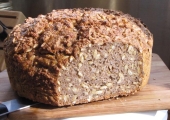


The Humble Soapnut - A Guide to the Laundry Detergent that Grows on Trees ebook by Kathryn Ossing
will be released to subscribers in:
soon!







Education: EAT Project * GROW
Projects: Keyhole-Hugel - Engine MOD
 1
1




Nerds be nerding...




Rapping about Permaculture? You betcha! http://www.permies.com/t/50884/art/Music-Permaculture




An important distinction: Permaculture is not the same kind of gardening as organic gardening.
Mediterranean climate hugel trenches, fabuluous clay soil high in nutrients, self-watering containers with hugel layers, keyhole composting with low hugel raised beds, thick Back to Eden Wood chips mulch (distinguished from Bark chips), using as many native plants as possible....all drought tolerant.




AKA Wilde Hilde
S.Oregon High Mountain Valley 8b
"Ensnar'd in flowers, I fall in the grass."-Marvell
 1
1















Roxanne Sterling-Falkenstein wrote:Yeasts need daily or every other day feeding no shortcuts




Kyrt Ryder wrote:
Roxanne Sterling-Falkenstein wrote:Yeasts need daily or every other day feeding no shortcuts
While there are no SHORTCUTS, doesn't the feeding pace dull down in cooler environments and times of year?
"You must be the change you want to see in the world." "First they ignore you, then they laugh at you, then they fight you, then you win." --Mahatma Gandhi
"Preach the Gospel always, and if necessary, use words." --Francis of Assisi.
"Family farms work when the whole family works the farm." -- Adam Klaus
 1
1











 3
3




"You must be the change you want to see in the world." "First they ignore you, then they laugh at you, then they fight you, then you win." --Mahatma Gandhi
"Preach the Gospel always, and if necessary, use words." --Francis of Assisi.
"Family farms work when the whole family works the farm." -- Adam Klaus




"You must be the change you want to see in the world." "First they ignore you, then they laugh at you, then they fight you, then you win." --Mahatma Gandhi
"Preach the Gospel always, and if necessary, use words." --Francis of Assisi.
"Family farms work when the whole family works the farm." -- Adam Klaus




R Scott wrote:And it is easy to dry and store your own starter. Just spread it thin on a piece of parchment and set on a cookie rack to dry. Crumble it and put into a baggie or jar and store as cold and dark as you can (freezer if you have one, coolest spot in the basement if you don't). Rehydrate and start again when you need it. It takes a week or two to get going again, so it isn't an instant ready thing but a great way to take a couple months off. Or, as we do, keep a couple spare starters in case one goes bad.
Follow some of my adventures in fiction writing here.
 1
1




Vera Stewart wrote:
My mind just exploded.
So...so...all these stories I've heard about "old timers" wandering around with sourdough starter necklaces to keep it warm and alive over the winter are...are...not necessary?











R Ranson wrote:
Vera Stewart wrote:
My mind just exploded.
So...so...all these stories I've heard about "old timers" wandering around with sourdough starter necklaces to keep it warm and alive over the winter are...are...not necessary?
I suspect they did this so they could make bread the next day. Freezing/cold slows down the yeast and it takes a few days to get active again.
If you are going more than a month between bread making, then drying definitely makes sense. It also helps to dry a few tablespoons of a particularly successful sourdough batch as a back up. A week between baking days, and keeping the starter going makes a tastier and easier to bake bread.
"You must be the change you want to see in the world." "First they ignore you, then they laugh at you, then they fight you, then you win." --Mahatma Gandhi
"Preach the Gospel always, and if necessary, use words." --Francis of Assisi.
"Family farms work when the whole family works the farm." -- Adam Klaus
 1
1









|
today's feeble attempt to support the empire
Unlock Free Wood Plans! Download free projects and create unique pieces now!
https:/the-art-of-regenerative-wood-working/
|




